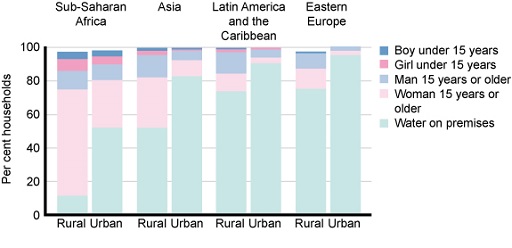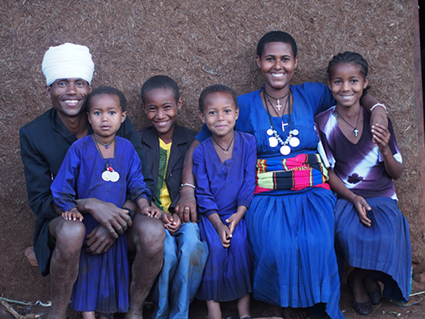8.2 Gender mainstreaming
How would you define gender mainstreaming?
Gender is not just about the biological differences between men and women but refers to their different roles, rights, and responsibilities, and the relations between them (UNDESA, n.d.). It is generally associated with unequal power and access to resources because, in many societies and cultures, men tend to dominate and consider women to be subordinate. Gender mainstreaming is a process that aims to address this imbalance.
This inequality is illustrated in Figure 8.1 which shows, in four major regions of the world, who is the usual person in a household responsible for collecting water.

You can see from the graph that in rural areas of sub-Saharan Africa (which includes Ethiopia) women and girls are more than four times as likely to be the water collectors as men and boys. Sanitation is also a major challenge for gender inequality. If women and girls have no alternative to open defecation, they are likely to feel embarrassment and shame and may be vulnerable to attack, especially if they wait until dark.
In Ethiopia, gender issues have been included in policies and strategies for some time. You may recall from Study Session 2 that the Water Resources Management Policy (1999) and the Water Sector Strategy (2001) both included statements about gender mainstreaming. Even before that, the Ethiopian Women’s Policy of 1993 recognised the importance of integrating gender concerns and spelled out the government’s commitment to abolish laws and regulations that discriminated against women (MoLSA, 2012).
Despite these policies, women are still excluded from many of the privileges and opportunities available to men. Girls who should be in school are not properly attending their education because they are expected to help with fetching water and other domestic tasks. As a result, they perform less well than male students. Within a family, it is usually the males who take priority rather than females. Although women are actively involved in society and have an average working day of between 13 and 17 hours they usually earn far less than men and are frequently not paid at all (MoLSA, 2012). Participation in decision making outside the home and discussions about community priorities may also be limited. Because of cultural traditions, females are sometimes not allowed to talk in public, and even when they do participate, the opinions of women may not be accepted if they conflict with those of the men (World Bank 2001, cited in Yilmaz and Venugopal, 2008).
By increasing access to safe water and sanitation throughout the country, the OWNP will bring a big improvement to the position of women and girls. By no longer having to spend time collecting water, they will be free to do more productive work and attend school, with obvious benefits for them and their families (Figure 8.2).

The Programme document includes a recommendation that training associated with the OWNP should follow gender mainstreaming guidelines (OWNP, 2013). The Gender Mainstreaming Field Manual for Water Supply and Sanitation Projects (MoWR, 2005) provides practical advice on how to make sure that all stages of Water Supply and Sanitation (WSS) projects including planning, surveys, data collection, analysis, implementation, operations and maintenance (O&M) and monitoring and evaluation (M&E) are all undertaken with gender mainstreaming at the forefront.
What examples or WASH sector organisations can you think of where women are explicitly included?
8.1 The concept of cross-cutting issues in the OWNP
